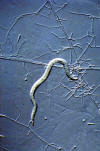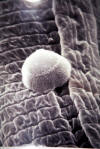 Arthrobotrys
dactyloides, A. brochopaga. Arthrobotrys
dactyloides, A. brochopaga. |
 |
a) Constricting ring traps - what triggers traps? |
|
Rev 01/01/20
Consider the complexity of soil biology:
Trap formation is stimulated in presence of nematodes - older literature referred to "Nemin" as a specific and mysterious stimulant that emanated from nematodes. But trap formation probably can be stimulated by a variety of proteins and amino acids. Jaffee shows that traps can be stimulated by exposure to soil solution extract without nematodes.
Trapping mechanisms involve initial adhesion followed by lectin binding, followed by penetration peg and hyphal development. Is there attraction of the nematodes to the trap?
A large number of endozoic fungi trap nematodes. Some of these fungi are saprophytic but can be facultatively parasitic if resources are present. Others are obligate parasites but can be cultured on artificial media. The taxonomy of these fungi is frequently in flux, particularly of those genera with various adhesive trapping mechanisms.
b) Sticky nets
|
 |
|
An example is Harposporium anguillulae, which has sickle-shaped spores that are ingested by bacterial feeding nematodes.
These fungi have motile zoospores that swim through natural body openings; zoosporangia fill body cavity. Could they be manipulated with irrigation? Catenaria spp.
| Pochonia chlamydosporia (formerly Verticillium chlamydosporium). Brian Kerry did extensive studies with this fungus as a regulator of Heterodera avenae in England. When cereals were grown, there was extensive damage due to the nematode initially, however after 7 years there was sufficient regulation of the nematode by the fungus to allow acceptable crop yields. |
Paecilomyces lilacinous, Dactylella oviparasitica are also egg parasites. D. oviparasitica is proving to ba an importantt agent in soils suppressive to the sugarbeet cyst nematode (Heterodera schachtii) if managed at high concentration levels in soil by frequent planting of a crop that is a host of the nematode.
| Adhesive spores - Pasteuria penetrans (formerly called Bacillus penetrans and Duboscquia penetrans). |

|
|
|
 |
Click on button below to view movie of Labronema feeding.
|
|
|
 |
|
|
Click on button below to view movie of Mononchus feeding. |

Amoebae - phylum Sarcomastigophora, kingdom Protista. |

Tardigrades (water bears) - phylum Tardigrada |
|
Turbellaria (flatworms)- class of phylum Platyhelminthes |
|

Colembolla - phylum Arthropoda, class Insecta |

Mites - phylum Arthropoda, class Arachnida. |
|||
Return to Plant Parasites Menu
For more information about nematodes, Go to Nemaplex Main Menu